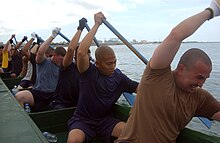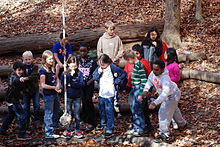Industrial and organizational psychology "focuses the lens of psychological science on a key aspect of human life, namely, their work lives. In general, the goals of I-O psychology are to better understand and optimize the effectiveness, health, and well-being of both individuals and organizations." It is an applied discipline within psychology and is an international profession. I-O psychology is also known as occupational psychology in the United Kingdom, organisational psychology in Australia and New Zealand, and work and organizational (WO) psychology throughout Europe and Brazil. Industrial, work, and organizational (IWO) psychology is the broader, more global term for the science and profession.
Virtual management, is the supervision, leadership, and maintenance of virtual teams—dispersed work groups that rarely meet face to face. As the number of virtual teams has grown, facilitated by the Internet, globalization, outsourcing, and remote work, the need to manage them has also grown. The following article provides information concerning some of the important management factors involved with virtual teams, and the life cycle of managing a virtual team.

A team is a group of individuals working together to achieve their goal.
Group dynamics is a system of behaviors and psychological processes occurring within a social group, or between social groups. The study of group dynamics can be useful in understanding decision-making behaviour, tracking the spread of diseases in society, creating effective therapy techniques, and following the emergence and popularity of new ideas and technologies. These applications of the field are studied in psychology, sociology, anthropology, political science, epidemiology, education, social work, leadership studies, business and managerial studies, as well as communication studies.

In the social sciences, a social group is defined as two or more people who interact with one another, share similar characteristics, and collectively have a sense of unity. Regardless, social groups come in a myriad of sizes and varieties. For example, a society can be viewed as a large social group. The system of behaviors and psychological processes occurring within a social group or between social groups is known as group dynamics.

Team building is a collective term for various types of activities used to enhance social relations and define roles within teams, often involving collaborative tasks. It is distinct from team training, which is designed by a combine of business managers, learning and development/OD and an HR Business Partner to improve the efficiency, rather than interpersonal relations.
Senior management, executive management, or upper management is an occupation at the highest level of management of an organization, performed by individuals who have the day-to-day tasks of managing the organization, sometimes a company or a corporation.
Team management is the ability of an individual or an organization to administer and coordinate a group of individuals to perform a task. Team management involves teamwork, communication, objective setting and performance appraisals. Moreover, team management is the capability to identify problems and resolve conflicts within a team. Teams are a popular approach to many business challenges. They can produce innovative solutions to complex problems. There are various methods and leadership styles a team manager can take to increase personnel productivity and build an effective team. In the workplace teams can come in many shapes and sizes who all work together and depend on one another. They communicate and all strive to accomplish a specific goal. Management teams are a type of team that performs duties such as managing and advising other employees and teams that work with them. Whereas work, parallel, and project teams hold the responsibility of direct accomplishment of a goal, management teams are responsible for providing general direction and assistance to those teams.
A virtual team usually refers to a group of individuals who work together from different geographic locations and rely on communication technology such as email, instant messaging, and video or voice conferencing services in order to collaborate. The term can also refer to groups or teams that work together asynchronously or across organizational levels. Powell, Piccoli and Ives (2004) define virtual teams as "groups of geographically, organizationally and/or time dispersed workers brought together by information and telecommunication technologies to accomplish one or more organizational tasks." As documented by Gibson (2020), virtual teams grew in importance and number during 2000-2020, particularly in light of the 2020 Covid-19 pandemic which forced many workers to collaborate remotely with each other as they worked from home.
Cooperative learning is an educational approach which aims to organize classroom activities into academic and social learning experiences. There is much more to cooperative learning than merely arranging students into groups, and it has been described as "structuring positive interdependence." Students must work in groups to complete tasks collectively toward academic goals. Unlike individual learning, which can be competitive in nature, students learning cooperatively can capitalize on one another's resources and skills. Furthermore, the teacher's role changes from giving information to facilitating students' learning. Everyone succeeds when the group succeeds. Ross and Smyth (1995) describe successful cooperative learning tasks as intellectually demanding, creative, open-ended, and involve higher-order thinking tasks. Cooperative learning has also been linked to increased levels of student satisfaction.
In business management, an autonomous work group is a group encouraged to manage its own work and working practices.
Transactive memory is a psychological hypothesis first proposed by Daniel Wegner in 1985 as a response to earlier theories of "group mind" such as groupthink. A transactive memory system is a mechanism through which groups collectively encode, store, and retrieve knowledge. Transactive memory was initially studied in couples and families where individuals had close relationships but was later extended to teams, larger groups, and organizations to explain how they develop a "group mind", a memory system that is more complex and potentially more effective than that of any of its individual constituents. A transactive memory system includes memory stored in each individual, the interactions between memory within the individuals, as well as the processes that update this memory. Transactive memory, then, is the shared store of knowledge.
Group emotion refers to the moods, emotions and dispositional affects of a group of people. It can be seen as either an emotional entity influencing individual members' emotional states or the sum of the individuals' emotional states.
Groupthink is a psychological phenomenon that occurs within a group of people in which the desire for harmony or conformity in the group results in an irrational or dysfunctional decision-making outcome. Cohesiveness, or the desire for cohesiveness, in a group may produce a tendency among its members to agree at all costs. This causes the group to minimize conflict and reach a consensus decision without critical evaluation.
Multiteam systems (MTSs) are "two or more teams that interface directly and interdependently in response to environmental contingencies toward the accomplishment of collective goals. MTS boundaries are defined by virtue of the fact that all teams within the system, while pursuing different proximal goals, share at least one common distal goal; and in doing so, exhibit input, process and outcome interdependence with at least one other team in the system". Multiteam systems describe collections of teams that work toward a common goal. MTSs are often conceptualized as larger than a single team, but smaller than the organization within which they are embedded. In fact, MTSs often traverse organizations such that teams embedded within the same MTS may hail from multiple organizations. These systems of teams can be conceptualized as a special type of social network. In particular, MTSs are social networks whose boundaries are based on the shared interdependence of all members toward the accomplishment of a higher-order network-level goal. Multiteam systems are different from teams, because they are composed of multiple teams that must coordinate and collaborate. In MTSs, component teams each pursue proximal team goals and at the same time, work toward the larger system level goal. Because of this dual focus on team goals and systems goals, there are many situations where interventions aimed at improving the internal cohesion of teams will come at a cost to the larger goal. The past decade has witnessed an explosion of interest in the social sciences in understanding multiteam systems. MTSs are thought to explain the dynamics that arise in the public sector such as Provincial Reconstruction Teams, and in the private sector with strategic alliances.
Team composition refers to the overall mix of characteristics among people in a team, which is a unit of two or more individuals who interact interdependently to achieve a common objective. It is based on the attributes among individuals that comprise the team, in addition to their main objective.
Positive interdependence is an element of cooperative and collaborative learning where members of a group who share common goals perceive that working together is individually and collectively beneficial, and success depends on the participation of all the members.

Selection, training, cohesion and psychosocial adaptation influence performance and, as such, are relevant factors to consider while preparing for costly, long-duration spaceflight missions in which the performance objectives will be demanding, endurance will be tested and success will be critical.

Team effectiveness is the capacity a team has to accomplish the goals or objectives administered by an authorized personnel or the organization. A team is a collection of individuals who are interdependent in their tasks, share responsibility for outcomes, and view themselves as a unit embedded in an institutional or organizational system which operates within the established boundaries of that system. Teams and groups have established a synonymous relationship within the confines of processes and research relating to their effectiveness while still maintaining their independence as two separate units, as groups and their members are independent of each other's role, skill, knowledge or purpose versus teams and their members, who are interdependent upon each other's role, skill, knowledge and purpose.
Team diversity refers to the differences between individual members of a team that can exist on various dimensions like age, nationality, religious background, functional background or task skills, sexual orientation, and political preferences, among others. Different types of diversity include demographic, personality and functional diversity, and can have positive as well as negative effects on team outcomes. Diversity can impact performance, team member satisfaction or the innovative capacity of a team. According to the Input-Process-Output Model, team diversity is considered an input factor that has effects on the processes as well as on the team outputs of team work.









